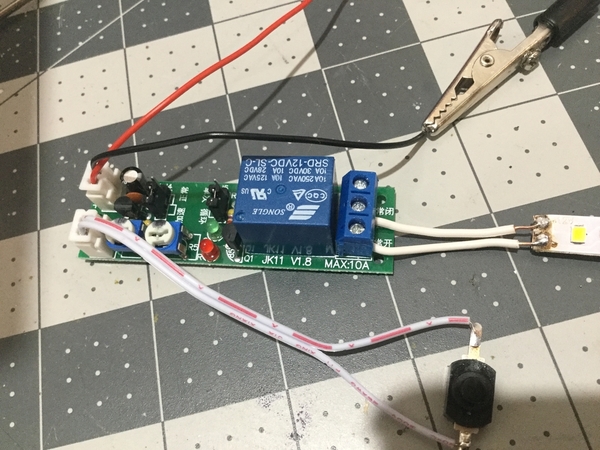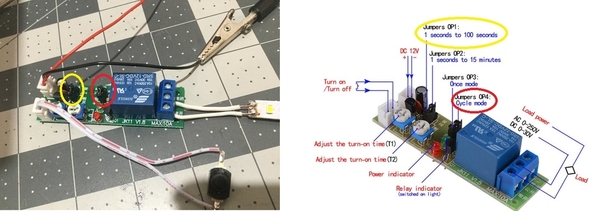Stan, i have one of these,but have yet to install it. My plans are to use it to stop a subway train (which runs on a dedicated track) for somewhere between 15 and 25 seconds (time to be decided later) at a station using a reed switch and magnet to activate it. I'll update you when i get it installed.
Even if you got what I claim is an eBay "Item Not As Described" it just might work as-is in your application!
In mine, for the short-range (0-100 sec) the minimum time delay is 0.1 sec at full CW setting. As you slowly turn the trimpot CCW to increase the delay the next delay jumps to ~4 sec, then jumps to ~13 sec, then ~17 sec, and goes up from there to, as stated earlier, about 4 minutes at the mid-point of the delay setting. Again, these are discrete "jumps" as opposed to a smooth change. So you might be able to find a suitable and stable delay in the 15-25 sec range if your module behaves as mine.
Stan2004,
yes that would be the board timing applications for model railroads if the pot worked correctly. I just didn't know if our experience with something similar would help. I can see now that your question is very specific for that unit.
We , also used them for an animated building.
Yes, the directions or specs are shaky. That is why I copied the listing.
Good luck with the vendor.
Am following this thread hoping to learn something.
My little experiment involves powering a Menards ambulance emergency lighting at intervals. I can get the relay to cycle, but the power doesn’t get to the test led strip to turn it on. Switching the wires around didn’t produce any positive result. Wired wrong or something... ???
Attachments
The LED strip requires power, all you're doing is connecting it across relay contacts! ![]()

You need to connect a 12VDC power supply in series with one of the leads to the LED strip and it'll light.
Attachments
So it’s a simple fact that I don’t understand how a relay works that kept me from proper operation. Works now of course. My misunderstanding was that the power from the source to relay also powered the led strip. ![]() Thx for the lesson.
Thx for the lesson.
Some lessons are easy, some are more painful. I think this is probably one of the easy ones, no magic smoke was involved. ![]()
Ted, thanks for posting the video and photo. You confirmed that the instructions are indeed incorrect on how to select between Once mode and Cycle mode.
Your jumpers are both in the lower position which imply OP1 short-time range (1-100 sec) and OP3 (Once mode). Yet you are clearly in Cycle mode.
It also appears your two adjustment pots are near but not at the full CW position. In my case, if at the full CW position the cycle time is very fast - 0.1 sec on, 0.1 sec off. But as I try to increase the on and off times by turning the adjustment slightly CCW, it jumps up to 5 sec or more each. So I can't get, say, 1 sec on and off (e.g., crossing gate alternating flasher). In your video it looks like you have a 13 sec cycle time. Can you get any "resolution" in the time setting to select, say, 1 sec or 2 sec or 3 sec, etc..?
Attachments
With a lot of tuning(fiddling), this is the best I could get with reliability. About a 1 second cycle. But to get something very precise is difficult at best. Hope this helps.
Attachments
Ted, thanks for following up - especially with posting a video. I think there's enough info now for guys to decide if this particular module is suitable for their application.
stan2004 posted:Ted, thanks for following up - especially with posting a video. I think there's enough info now for guys to decide if this particular module is suitable for their application.
So another probably dumb question; can I use the same 12vdc buss to power the relay, and then the ambulance on the other end?(using two taps) Or, do they have to be separate(isolated) power sources?
Same 12V DC power supply can power the timer-module (via red-black wires) and ambulance (assuming it accepts 12V DC).
But isn't this what your video shows? That is, a single 12V DC supply powering both the timer-module as well as the LED strip.
stan2004 posted:Same 12V DC power supply can power the timer-module (via red-black wires) and ambulance (assuming it accepts 12V DC).
But isn't this what your video shows? That is, a single 12V DC supply powering both the timer-module as well as the LED strip.
No, I used separate supplies to be sure I wasn’t making that mistake. Remember the digital volt/amp meters, they had to be isolated. Also, the ambulance is 4.5vdc, was going to use a dc step down converter on that end, then out to the ambulance. Run for 30” then off for 4-5’.
Got it. So same 12V DC bus can drive the timer-module AND another DC-DC converter set to 4.5V DC. Then the 4.5V DC goes thru the COM and NO contacts of the timer-module to cycle the 4.5V Ambulance.
Perhaps obvious, but you can connect the 4.5V DC output from the DC-DC converter (before it goes thru the relay) to other Menards buildings/vehicles that are always ON (don't need cycling).
So to bring my little experiment full circle, I was successful in hooking up my little Menards ambulance up to the timer relay. This is using one power supply for the ambulance and a second to power the relay.












